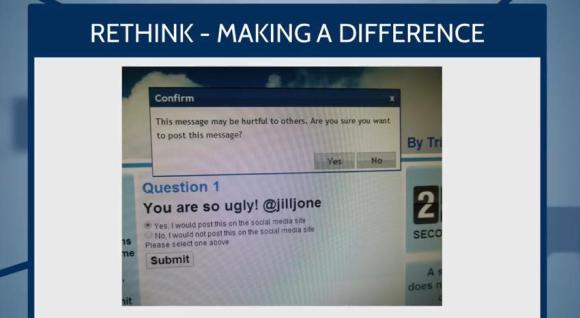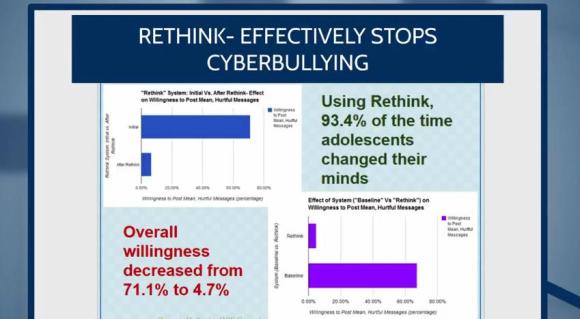
Bullying is not a new phenomenon. Even if you haven’t personally experienced it, you likely know some who has been bullied, or have seen it happen to someone else. So have our parents, and most likely their parents too. Adults can be bullies too, but children and adolescents are much more likely to act without thinking, making it much more of a problem for the younger generation.
What is a relatively new phenomenon, however, is cyber bullying. After hearing about a young girl who was bullied to the point that she decided to commit suicide, 14-year-old Trisha Prabhu knew something had to be done, and set to work making a system that could drastically reduce the incidences of cyber bullying.
With technology and social media now a part of our everyday lives, it’s not much of a surprise that the taunting and teasing of classmates and peers has taken on a new form. Now, not only is it just mean words and occasional fistfights in the school yard, it is hateful and embarrassing words, photos, and videos permanently and publicly displayed for anyone to see. The anonymity that the internet often provides only exacerbates the situation.
When Trisha heard the news of the young girl who took her own life because of the relentless online teasing she endured, the young teen was heartbroken, and decided then to do what she could to prevent something like that from happening again.
It was after learning of a particular fact about adolescent brains that she was able to come up with her brilliant idea. The fact is, as our brains develop, they develop from from back to front, the front part of the brain not being fully developed until around age 25. That front part of our brains is what helps us with decision-making. This is why kids are more likely to act on impulses without considering the consequences. When it’s so easy, second nature even for the youth of today, to type up a text message or comment and hit ‘send’, they may not always think about the effect of their words or their actions.
“What if I gave them a chance to think about what they were doing?” Trisha wondered, as she set out on her mission and created the product Rethink, which creates an alert before a potentially offensive message is posted, asking the poster if they really want to write something that could hurt someone else, giving them the chance to stop and think about what they are doing.
In her trial studies, Trisha found that over 93% of the time, when adolescents received that message, they changed their willingness to post the offensive material.
While still in development, Rethink has already gotten Trisha many awards and praise, and she hopes to soon have it available as a Chrome browser extension and mobile add-on, to help stop cyber bullying worldwide.
Trisha’s idea has even reached across to Japan, where bullying is a particularly big problem, cyber-bullying included (something which is known as ネットいじめ netto ijime, netto being the shortened word for internet, and ijime meaning bully or bullying).
https://twitter.com/kaede_d_andmori/status/560129955334348800▲”It’s just one simple warning, but it’s so important. This is an amazing discovery! But with all the thick-headed parents and stuff around in Japan, adults probably need this too…”
勢いで行く前に一回手を止めて考える。それだけのことなのに、こうやって形にして効果をあげることがすごい / 夢はネットいじめの撲滅。14歳の少女が未成年の9割から侮辱的な投稿を無くした方法とは? http://t.co/CJ96VzHDiO @misterspotlightさんから
— ヲンタロー (@swk650r) January 28, 2015
▲”Stop and think before you recklessly act. Such a simple thing, it’s amazing that it’s had this kind of result.”
https://twitter.com/Yoshiwo_Yoshida/status/560235781990539264▲”This is great. I wonder if Japan will use this for the internet and apps too. We’ve rushed too fast into this net-based society.”
At the Zenkoku Ijime Mondai Kodomo Samitto (directly translated as Nationwide Bullying Problem Children’s Summit) held in Tokyo last Saturday, January 24, Japanese youth were also discussing ways to address and prevent the bullying problem that is so prominent in their country.
Is bullying a problem in your country as well? Do you think Trisha’s Rethink system will be successful? Let us know what you think!
Source: YouTube, NAVER Matome
Images: YouTube




 Tough-as-nails bullied Japanese schoolgirl stays home from school, but not because she was sad
Tough-as-nails bullied Japanese schoolgirl stays home from school, but not because she was sad Japanese Twitter user’s sad memory of when school literally refused to look at bullying problem
Japanese Twitter user’s sad memory of when school literally refused to look at bullying problem When bullying happens in Japan, should parents go to the police? We ask an educator
When bullying happens in Japan, should parents go to the police? We ask an educator Parents of bullied teenage girl who committed suicide commission portrait to “attend” Seijinshiki
Parents of bullied teenage girl who committed suicide commission portrait to “attend” Seijinshiki You can now buy bully insurance for your kids in Japan
You can now buy bully insurance for your kids in Japan Mysterious light-up rainy night-sound Totoro figure doesn’t actually show a scene from the anime
Mysterious light-up rainy night-sound Totoro figure doesn’t actually show a scene from the anime Studio Ghibli showcases traditional craftsmanship with new wallet range
Studio Ghibli showcases traditional craftsmanship with new wallet range Does Japan’s T.M. Revolution J-rock cake really look like the song it’s named after?
Does Japan’s T.M. Revolution J-rock cake really look like the song it’s named after? Japanese company develops classy heavy metal band frames for glasses
Japanese company develops classy heavy metal band frames for glasses Studio Ghibli tea blends contain ingredients inspired by My Neighbour Totoro
Studio Ghibli tea blends contain ingredients inspired by My Neighbour Totoro Major Japanese city is abolishing extracurricular activities at all of its middle schools
Major Japanese city is abolishing extracurricular activities at all of its middle schools Possessing Harry Potter’s Sword of Godric Gryffindor is now illegal in Japan
Possessing Harry Potter’s Sword of Godric Gryffindor is now illegal in Japan Japanese women reveal how far they’ve gone in “stalking” a guy they like in survey
Japanese women reveal how far they’ve gone in “stalking” a guy they like in survey We spend Culture Day in prison, food was arguably better than Yoshinoya
We spend Culture Day in prison, food was arguably better than Yoshinoya Discovery of Death Note-inspired hit list in New Hampshire school has families on high alert
Discovery of Death Note-inspired hit list in New Hampshire school has families on high alert Japan’s Kanji of the Year announced, shows the bright and dark spots of 2024【Video】
Japan’s Kanji of the Year announced, shows the bright and dark spots of 2024【Video】 Japan’s tap-to-pay Suica train card system aims to go tapless with walk-through gates, location data scans
Japan’s tap-to-pay Suica train card system aims to go tapless with walk-through gates, location data scans Starbucks teams up with 165-year-old Kyoto doll maker for Year of the Snake decorations【Photos】
Starbucks teams up with 165-year-old Kyoto doll maker for Year of the Snake decorations【Photos】 One of Japan’s rarest sweets is a sell-out hit that looks and tastes like frost
One of Japan’s rarest sweets is a sell-out hit that looks and tastes like frost Over 800 Studio Ghibli anime world paintings compiled in beautiful new hardcover art book【Pics】
Over 800 Studio Ghibli anime world paintings compiled in beautiful new hardcover art book【Pics】 Japanese city paints well-known prostitution street bright yellow, adds fish art【Video】
Japanese city paints well-known prostitution street bright yellow, adds fish art【Video】 Uniqlo announces first-ever collaboration with horror manga master Junji Ito【Photos】
Uniqlo announces first-ever collaboration with horror manga master Junji Ito【Photos】 J-pop mega star Ado reveals she’s been living in the U.S., may not understand language acquisition
J-pop mega star Ado reveals she’s been living in the U.S., may not understand language acquisition Starbucks Japan is calling it quits with paper straws
Starbucks Japan is calling it quits with paper straws Studio Ghibli releases new range of cardigans for anime fans
Studio Ghibli releases new range of cardigans for anime fans Japan’s most popular castle raising ticket prices by up to 200 percent for non-local tourists
Japan’s most popular castle raising ticket prices by up to 200 percent for non-local tourists Furikake rice seasoning sales are soaring, which is bad news for Japan as a whole
Furikake rice seasoning sales are soaring, which is bad news for Japan as a whole Studio Ghibli heroine cardigans give you warmth and strength to face everyday challenges
Studio Ghibli heroine cardigans give you warmth and strength to face everyday challenges Eight unforgettable hot springs, as recommended by Japan’s “Professor Bath”
Eight unforgettable hot springs, as recommended by Japan’s “Professor Bath” Berserk T-shirts coming to Uniqlo for launch of new Manga Curation line【Photos】
Berserk T-shirts coming to Uniqlo for launch of new Manga Curation line【Photos】 McDonald’s new Happy Meals offer up cute and practical Sanrio lifestyle goods
McDonald’s new Happy Meals offer up cute and practical Sanrio lifestyle goods Foreign tourists on Shinkansen bullet train break suitcase etiquette, angering local passengers
Foreign tourists on Shinkansen bullet train break suitcase etiquette, angering local passengers [Deleted] Article written for April Fool’s Day 2018
[Deleted] Article written for April Fool’s Day 2018 Japanese government to make first change to romanization spelling rules since the 1950s
Japanese government to make first change to romanization spelling rules since the 1950s Foreigner’s request for help in Tokyo makes us sad for the state of society
Foreigner’s request for help in Tokyo makes us sad for the state of society Japanese convenience store Family Mart announces abolishment of eat-in spaces
Japanese convenience store Family Mart announces abolishment of eat-in spaces Life-size vibrating Legend of Zelda Master Sword for sale from Nintendo【Photos】
Life-size vibrating Legend of Zelda Master Sword for sale from Nintendo【Photos】 Princesses, fruits, and blacksmiths: Study reveals the 30 most unusual family names in Japan
Princesses, fruits, and blacksmiths: Study reveals the 30 most unusual family names in Japan Studio Ghibli releases free-download board game — Here’s how to play it without reading Japanese
Studio Ghibli releases free-download board game — Here’s how to play it without reading Japanese “Bully insurance” now on the rise, with many more practical uses than just insuring bullying
“Bully insurance” now on the rise, with many more practical uses than just insuring bullying Court verdict reached on Kyoto schoolgirl who sued bullies for causing her mental illness
Court verdict reached on Kyoto schoolgirl who sued bullies for causing her mental illness Poignant video about inner beauty is an unlikely ad for a beauty clinic 【Video】
Poignant video about inner beauty is an unlikely ad for a beauty clinic 【Video】 Saitama lieutenant calls subordinate’s lunch “garbage”, then loses job for eating garbage lunches
Saitama lieutenant calls subordinate’s lunch “garbage”, then loses job for eating garbage lunches Japanese Twitter tears up over touching tale of why bullied child never contemplated suicide
Japanese Twitter tears up over touching tale of why bullied child never contemplated suicide Curry restaurants across Japan create social media movement: “Don’t blame the curry!”
Curry restaurants across Japan create social media movement: “Don’t blame the curry!” Councilman Super Crazy Kun begins work, but considerably less crazy looking
Councilman Super Crazy Kun begins work, but considerably less crazy looking Why is the iPhone the smartphone of choice for young Japanese women?
Why is the iPhone the smartphone of choice for young Japanese women? Try our crappy lifehack for “better BMs”
Try our crappy lifehack for “better BMs” Email spam exhibition held online by Japanese telecom giant
Email spam exhibition held online by Japanese telecom giant Half-Chinese woman undergoes extensive cosmetic surgery to become the next living Barbie doll
Half-Chinese woman undergoes extensive cosmetic surgery to become the next living Barbie doll Can’t cope with the feeding frenzy at meal times? Why not stack your cats!
Can’t cope with the feeding frenzy at meal times? Why not stack your cats! If you want your kids to go to elite universities, give them Legos, Japanese study says
If you want your kids to go to elite universities, give them Legos, Japanese study says Japanese child’s sad story of learning that “goodwill” is sometimes just “self-satisfaction”
Japanese child’s sad story of learning that “goodwill” is sometimes just “self-satisfaction”
Leave a Reply